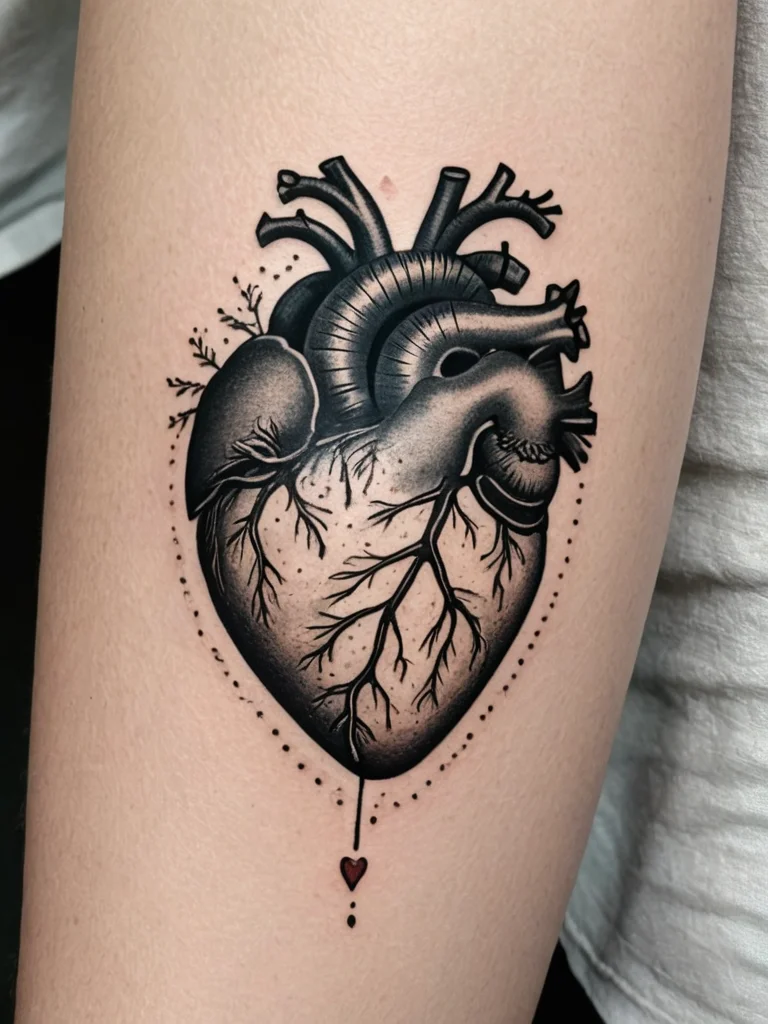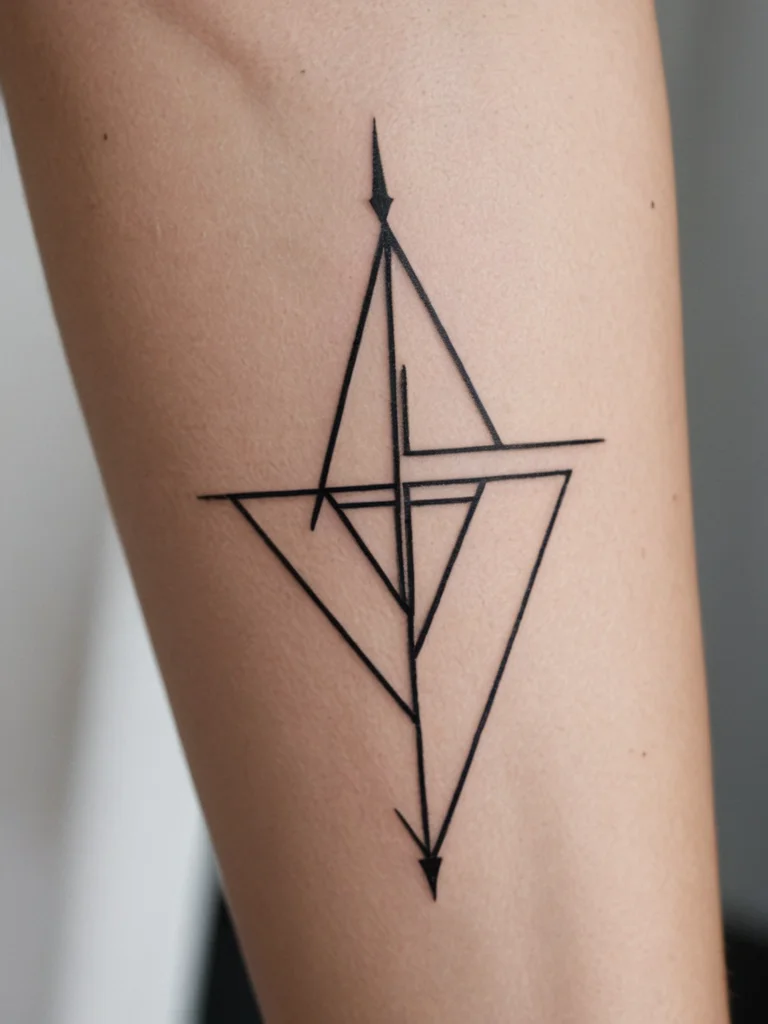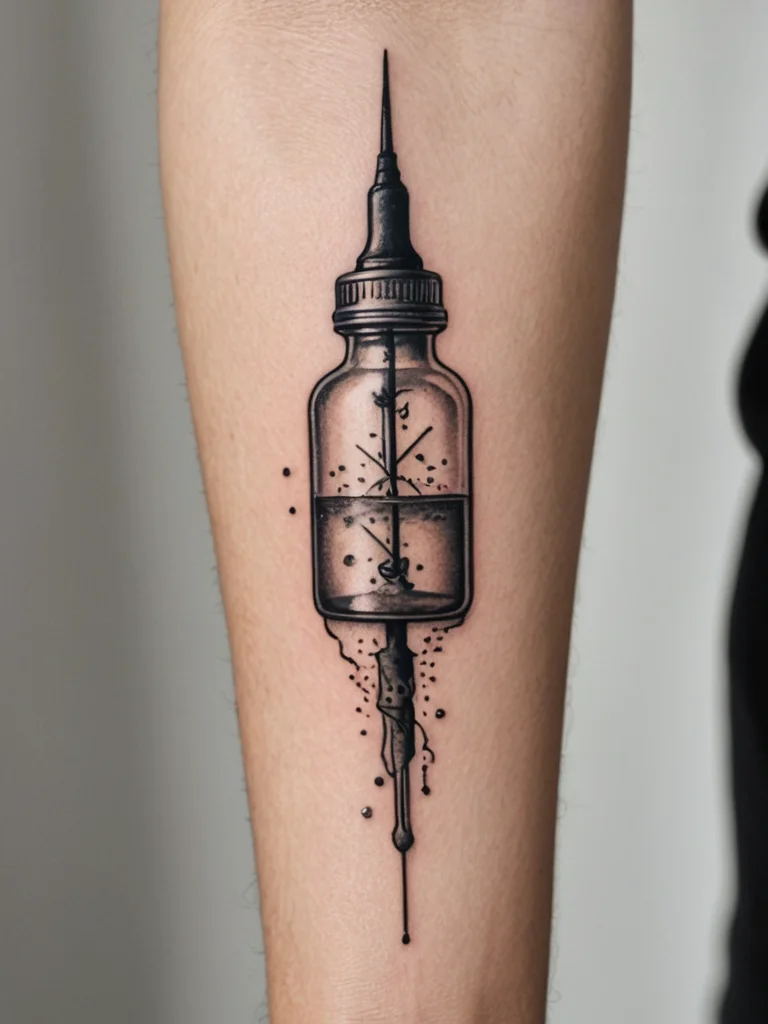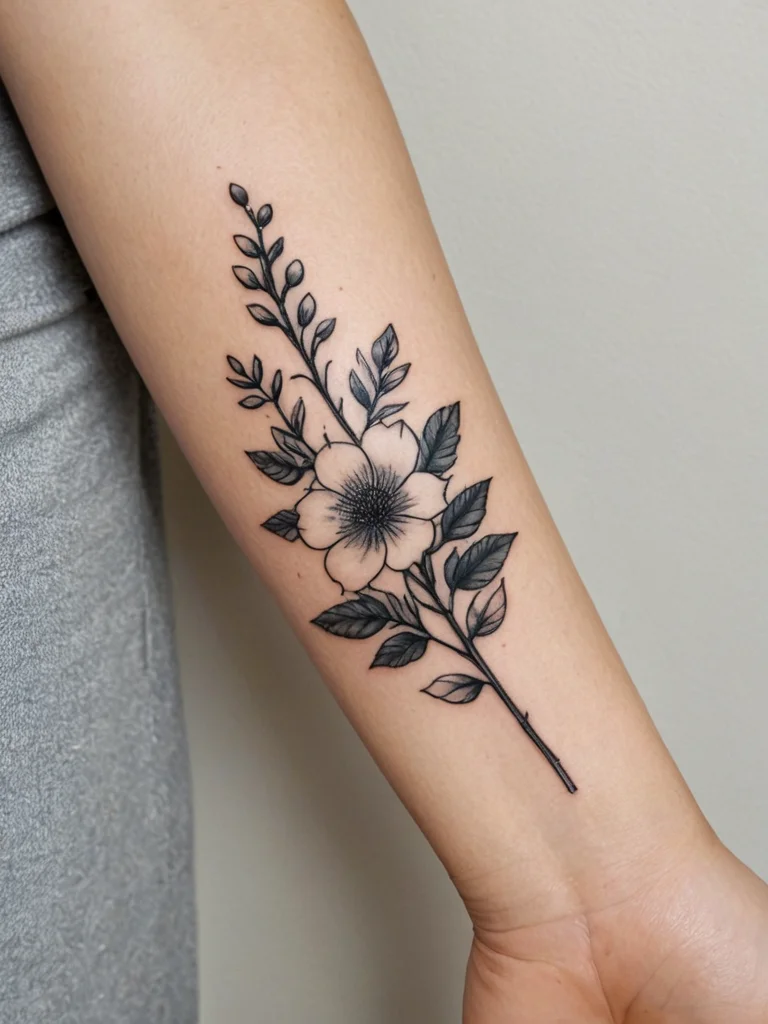The world of tattoos is vast and ever-evolving, offering a spectrum of styles and methods to adorn your skin. Among the more accessible and often romanticized techniques is the stick and poke tattoo, also known as a hand-poked tattoo. This method, characterized by its manual application and often minimalist aesthetic, has seen a resurgence in popularity, appealing to those seeking a more intimate, DIY approach to body art. Unlike the buzzing hum of a tattoo machine, the stick and poke process is quiet, deliberate, and deeply personal, allowing for a unique connection between the artist and the canvas. It’s a method that harks back to the earliest forms of tattooing, predating modern machinery by millennia, and offers a distinct aesthetic that many find incredibly appealing.
What exactly is a stick and poke tattoo? the diy art explained

At its core, a stick and poke tattoo is created by manually inserting ink into the dermis layer of the skin using a sharp implement, typically a needle, attached to a handle. This handle can be anything from a simple stick, hence the name, to a more refined grip designed for comfort and control. The artist repeatedly dips the needle into tattoo ink and then punctures the skin rhythmically, creating dots that, when viewed together, form a design. This pointillist approach is what gives many stick and poke tattoos their characteristic soft, slightly blurred, and often imperfect charm. It’s a meticulous, time-consuming process that relies on the artist’s steady hand and patience. The resulting lines might appear less solid and more textured than those produced by a tattoo machine, offering a unique, often delicate, visual quality. This simplicity is part of its allure, making it accessible for both aspiring artists and those looking for subtle, meaningful body art.
The simplicity of the tools involved is a key differentiator. While professional tattoo machines use electromagnetic coils or rotary motors to rapidly drive needles in and out of the skin, a stick and poke artist manually pushes the needle into the skin for each individual dot or line segment. This direct, manual control allows for a unique level of precision, especially for small, intricate designs. It’s a process that requires immense focus, as each poke contributes to the final image. This hands-on nature fosters a strong connection between the artist and the tattoo, making each piece feel truly bespoke. The aesthetic often leans towards minimalist designs, fine lines, and geometric patterns, though more complex creations are certainly possible with skill and dedication.
The materials used are crucial for both the aesthetic outcome and safety. High-quality tattoo ink, specifically formulated for skin implantation, is essential. The needle must be sterile and new, ideally a single-use, disposable needle designed for tattooing. The grip or handle should also be clean and sterilized, or made of a disposable material. While the concept can sound rudimentary, when performed with proper sterile equipment and technique, it yields beautiful and lasting results. However, the potential for unsanitary practices is also a concern, which we will delve into further.
The evolution of stick and poke: from ancient practice to modern trend

The practice of hand-poking tattoos is far from a new phenomenon; it is, in fact, one of the oldest methods of tattooing known to humankind. Archaeological evidence and ethnographic studies suggest that various forms of manual tattooing have been practiced across cultures for thousands of years. Before the invention of electric tattoo machines, this was the only way to permanently mark the skin. From the intricately patterned tattoos of the Maori people in New Zealand, often applied with bone or wood implements and the traditional name ‘moko’, to the practices found in ancient Egypt and across various indigenous communities in Asia and the Americas, the needle and ink, manually applied, formed the foundation of tattooing traditions.
Historically, these tattoos often held deep cultural, spiritual, and social significance. They could signify status, lineage, achievements, or protection. For instance, the practice among the Igorot people of the Philippines, known as ‘batok’, involved using a comb-like tool made of bone or wood dipped in ink and struck with a stick to drive it into the skin. These tattoos were often passed down through generations and carried profound ancestral connections. Similarly, the Ötzi the Iceman, whose remarkably preserved body dates back over 5,000 years, bore simple line tattoos, believed by some to have been therapeutic, possibly applied through a method akin to stick and poke.
In more recent history, the stick and poke style gained traction in subcultures, particularly within the punk and prison communities, during the latter half of the 20th century. Often performed in makeshift environments with less-than-ideal sterilization, these tattoos became associated with rebellion, counter-culture, and DIY ethos. However, as the stigma around tattoos began to fade and appreciation for minimalist and unique aesthetics grew, the stick and poke method began to shed its rougher associations. It re-emerged in the mainstream art and fashion scenes, embraced for its delicate lines, intentional imperfections, and the personal narrative it often carries. Today, many artists specialize in this technique, elevating it with meticulous attention to hygiene, design, and artistry, transforming it from a clandestine practice into a celebrated form of body art.
Stick and poke vs. machine tattoos: key differences and what to expect

The most apparent difference between stick and poke and machine tattoos lies in the application method. Tattoo machines utilize a rapid up-and-down motion of needles, powered by electricity, to deposit ink. This allows for the creation of solid lines, smooth shading, and vibrant color packing that can be achieved relatively quickly. The speed and efficiency of the machine enable artists to cover larger areas and create more complex, detailed designs with a higher degree of uniformity. The sensation from a machine tattoo is often described as a buzzing or vibrating feeling, which can be intense but is generally consistent throughout the session.
Stick and poke tattoos, on the other hand, are applied dot by dot, manually. This results in a softer, more textured line quality, often with a delicate, almost hand-drawn appearance. The process is significantly slower, requiring considerable time and patience from both the artist and the client. Because of this, stick and poke tattoos are often favored for smaller, simpler designs, fine lines, and minimalist aesthetics. The sensation is typically described as a sharp prick or sting with each individual poke, which can be less jarring than the vibration of a machine for some, but the sheer number of pokes can still be intense. The outcome is usually a more subtle, understated tattoo that possesses a distinct handmade charm.
When it comes to pain, experiences can vary greatly depending on individual pain tolerance, the location of the tattoo, and the skill of the artist. However, many find the steady, rhythmic pricking of a stick and poke tattoo to be more manageable than the sustained buzzing of a machine, especially for shorter sessions. Healing can also differ. Machine tattoos, due to the trauma inflicted by the rapid needle action, might sometimes require a bit more attention during the initial healing phase. Stick and poke tattoos, when done correctly, can sometimes heal quite smoothly due to the less invasive nature of individual pokes, though proper aftercare is always paramount for any tattoo.
Longevity is another point of consideration. Both methods, when performed correctly with quality ink and proper aftercare, can result in tattoos that last a lifetime. However, the subtle nature of stick and poke lines might mean that they can fade or blur slightly more over many years compared to the bolder, more densely packed ink of machine tattoos. Regular touch-ups might be necessary for stick and poke tattoos to maintain their crispness, but this is also true for many machine tattoos as well. Ultimately, the choice between the two often comes down to the desired aesthetic, the complexity of the design, and the personal connection you seek with the tattooing process.
Is a stick and poke tattoo safe? essential health & hygiene guidelines

Safety and hygiene are paramount when considering any form of tattooing, and stick and poke is no exception. The DIY nature of this method unfortunately means that the potential for unsafe practices is higher if one is not fully educated or equipped. The most critical aspect is ensuring that all equipment used is sterile and single-use. This includes the needle, which should be a brand-new, sterile tattoo needle. Disposable needles are readily available and should be the only option. Sharing needles or using non-sterile needles, such as sewing needles or safety pins, poses severe health risks, including the transmission of bloodborne pathogens like Hepatitis B, Hepatitis C, and HIV.
Furthermore, the ink must be professional-grade tattoo ink. India ink or pen ink are not suitable for tattooing, as they can contain impurities that may cause allergic reactions or lead to the tattoo healing poorly and fading quickly. Always ensure your artist uses ink from reputable tattoo supply companies. Proper sterilization of all surfaces and tools is also non-negotiable. This includes the ink caps, gloves, and any equipment that comes into contact with the skin or ink. Artists should wear new, sterile gloves for the entire duration of the tattooing process and change them if they come into contact with any non-sterile surface.
The tattooing environment itself must be clean and sanitary. A professional tattoo studio that offers stick and poke services will adhere to the same strict hygiene standards as they would for machine tattooing. If you are considering getting a stick and poke tattoo, whether from a professional or a friend who has experience, always ask about their sterilization procedures. Do not hesitate to inquire about their needles, inks, and overall cleanliness. A responsible artist will be transparent and happy to demonstrate their adherence to safety protocols. Your health is far more important than the tattoo itself, and choosing a safe, sterile practice ensures that your body art is a positive addition to your life, rather than a health hazard.
Aftercare is just as crucial as the tattooing process itself for ensuring a safe and healthy outcome. Proper cleaning and moisturizing of the freshly tattooed area, following the artist’s instructions, will help prevent infection and promote optimal healing. This typically involves gently washing the area with mild, fragrance-free soap and water, patting it dry with a clean paper towel, and applying a thin layer of a recommended ointment or lotion. Avoiding soaking the tattoo in water (like baths or swimming pools), direct sunlight, and tight clothing over the tattooed area during the initial healing period is also vital. Following these guidelines diligently will help your stick and poke tattoo heal beautifully and remain a cherished piece of art.
Designing your stick and poke: inspiration, placement, and longevity tips

The minimalist and often delicate nature of stick and poke tattoos lends itself beautifully to certain design choices. Fine lines, geometric shapes, abstract patterns, small symbols, and simple illustrations are all excellent candidates for this technique. Think about elements that can be effectively rendered using dots and single lines, such as constellations, minimalist animal outlines, botanical drawings, or abstract floral designs. Many people opt for stick and poke tattoos for their personal significance, choosing symbols that represent important life events, personal mantras, or loved ones. The process itself, being so intimate and deliberate, often encourages designs that hold deep personal meaning.
Placement is a key consideration for any tattoo, but it can be particularly important for stick and poke designs. Areas with less friction and softer skin tend to heal better and preserve the fine details of a hand-poked tattoo over time. Consider placements like the inner wrist, ankle, behind the ear, or fingers for smaller pieces. However, be aware that tattoos on areas with constant friction, like fingertips or the inside of the mouth, tend to fade much faster regardless of the application method. Areas with thinner skin, like the inner elbow or behind the knee, can also be more sensitive during the process.
When thinking about longevity, it’s helpful to choose designs that are not overly intricate or reliant on extremely fine, closely spaced lines. While a skilled artist can achieve remarkable detail, these delicate features may blur slightly over many years. Boldness in the design, even with a stick and poke technique, can contribute to its lasting power. For example, a slightly thicker outline or a design with more distinct dot clusters might hold up better long-term than a very wispy, airy pattern. Discussing your desired placement and the longevity of your chosen design with an experienced stick and poke artist is highly recommended. They can offer valuable insights into how different lines and dot densities will age on specific areas of your skin.
The personal journey of creating and receiving a stick and poke tattoo is often as meaningful as the final artwork. Whether you’re drawn to its historical roots, its minimalist aesthetic, or its intimate creation process, a stick and poke tattoo can be a powerful and beautiful way to express yourself. By prioritizing safety, choosing a skilled artist, and selecting a design that resonates with you, you can ensure a positive and lasting experience with this unique form of body art. It’s a practice that celebrates individuality, patience, and the enduring beauty of art applied directly, by hand, to the skin.